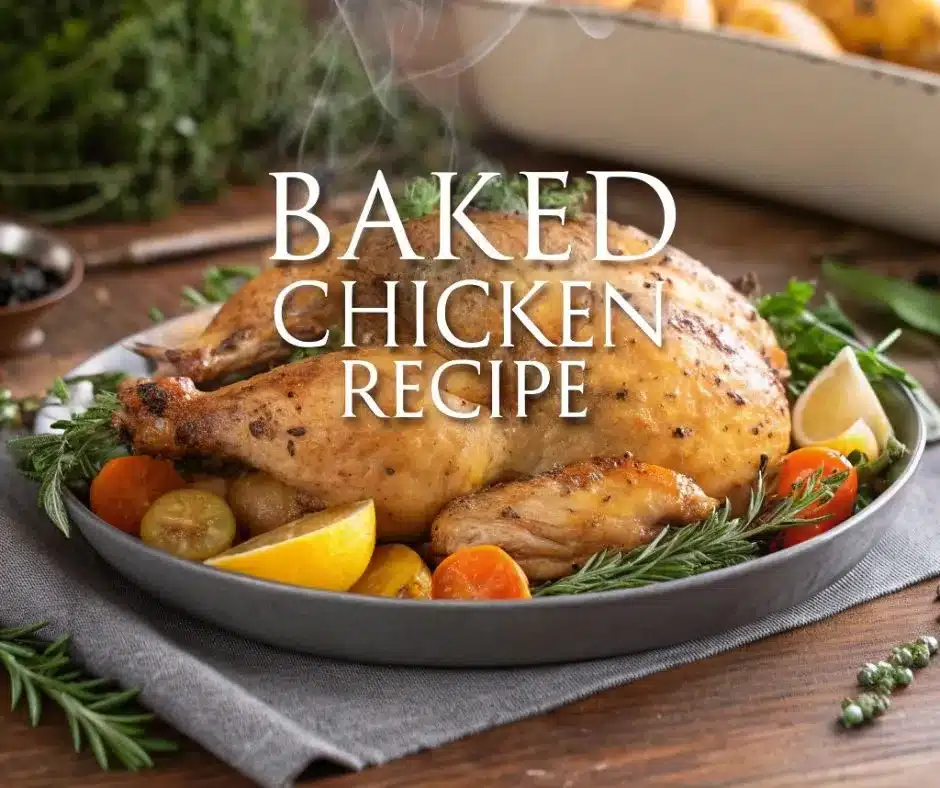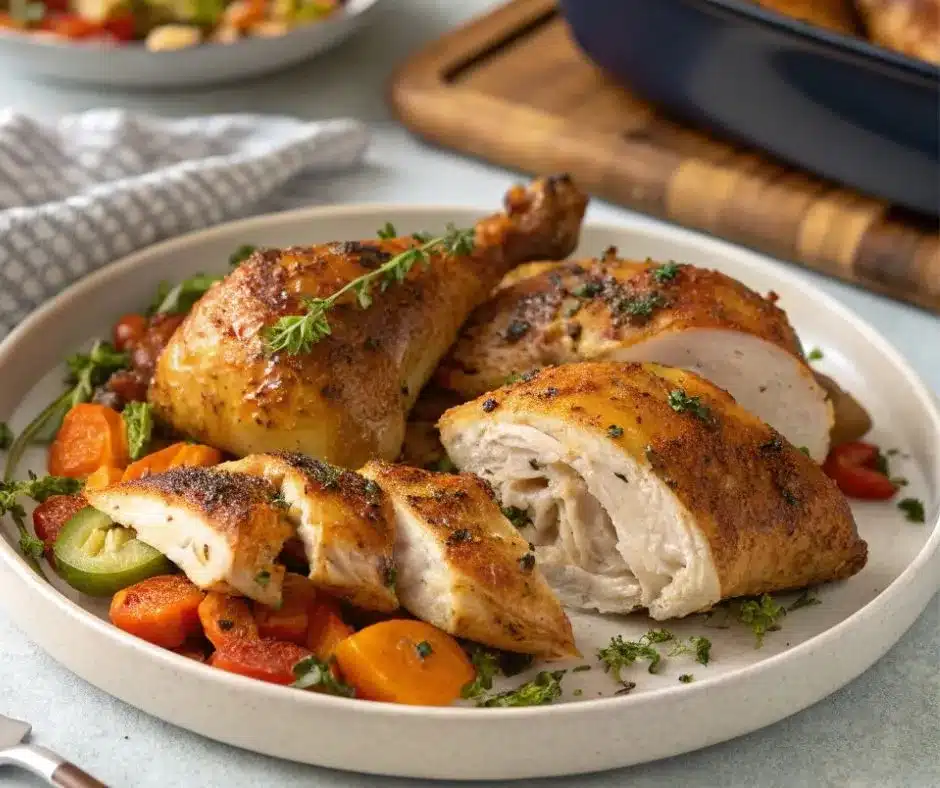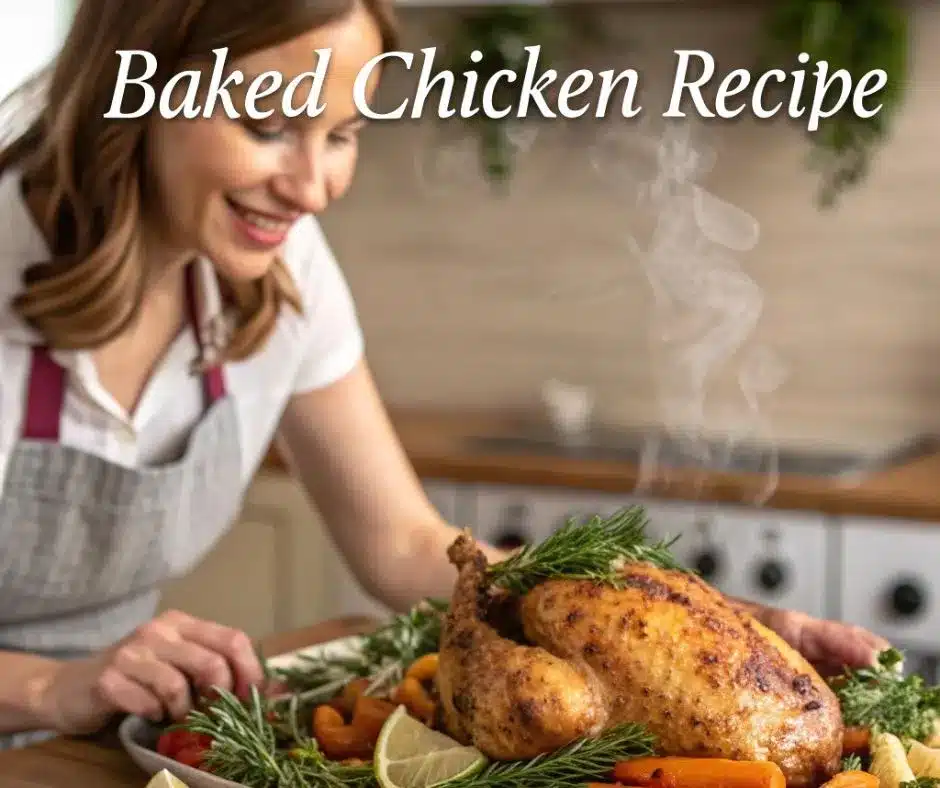Introduction
Baked chicken is a timeless dish that combines simplicity and flavor, making it a go-to option for countless households. Whether you’re cooking for a busy weeknight dinner or a special occasion, a baked chicken recipe provides a versatile canvas for a wide variety of seasonings and side dishes. With minimal preparation, baked chicken can be transformed into a wholesome and satisfying meal that caters to all tastes.
What makes baked chicken recipe so appealing is its ability to retain moisture while delivering a crispy, golden exterior when cooked properly. Unlike frying, baking is a healthier method that doesn’t require excessive oil, making it an excellent choice for those seeking a nutritious yet delicious option.
From traditional seasoning blends to innovative marinades, a baked chicken recipe can be customized to suit your flavor preferences. Moreover, it’s a crowd-pleaser for families, easy to prepare in large batches, and an ideal choice for meal prepping. If you’re looking for a reliable dish that checks all the boxes—delicious, healthy, and versatile—a baked chicken recipe is the answer.
History of Baked Chicken
The Origins of Baked Chicken

The practice of baking chicken dates back thousands of years, rooted in the origins of cooking itself. Early civilizations used primitive ovens, often constructed from clay or stone, to bake meats, including chicken. This method of cooking allowed communities to prepare food in a controlled, even-heating environment, which enhanced both flavor and texture. For instance, Ancient Egyptians are believed to have baked chicken using herbs and spices, showcasing the enduring appeal of seasoning baked chicken for extra flavor.
Baked Chicken Across Cultures
Baked chicken has evolved into a culinary staple across various cultures, each infusing its own unique flavors and techniques. In Mediterranean cuisine, for example, a baked chicken recipe is often seasoned with olive oil, lemon, garlic, and a blend of herbs like oregano and thyme. In contrast, Asian cooking features marinades with soy sauce, ginger, and honey to create a sweet and savory glaze for baked chicken dishes. Similarly, Latin American recipes frequently highlight bold spices such as cumin, paprika, and chili powder, resulting in a rich and robust flavor profile.
Evolution of Modern Baked Chicken Recipes
The modern approach to baked chicken has been shaped by innovations in kitchen appliances and culinary techniques. With the advent of temperature-controlled ovens, home cooks gained the ability to bake chicken with precision, ensuring consistent results every time. Additionally, the rise of health-conscious cooking has increased the popularity of baked chicken recipe as an alternative to fried dishes. Today, recipes range from classic roasted baked chicken to creative takes like stuffed or sheet-pan baked chicken, reflecting the dish’s versatility and timeless appeal.
Ingredients and Preparation
Essential Ingredients for Baked Chicken
Creating a perfectly baked chicken starts with selecting the right ingredients. Here’s what you’ll need for a classic baked chicken recipe:
- Chicken: Choose your preferred cut—whole chicken, thighs, drumsticks, or breasts. Bone-in and skin-on cuts tend to retain more moisture during baking.
- Oil or Butter: A light coating of olive oil or melted butter helps create a golden, crispy skin while locking in moisture.
- Seasonings: Salt, pepper, and garlic powder are staples, but you can add paprika, thyme, rosemary, or your favorite spice blends for extra flavor.
- Optional Extras: Lemon slices, fresh herbs, or vegetables like carrots and potatoes can be added for a complete, flavorful baked chicken dish.
Step-by-Step Instructions for Baking Chicken
- Preheat the Oven: First, set your oven to 375°F (190°C) for bone-in cuts or 400°F (204°C) for boneless pieces.
- Prepare the Chicken: Next, pat the chicken dry with paper towels to ensure a crispy finish.
- Season: Then, rub the chicken with olive oil or butter, and sprinkle generously with salt, pepper, and your preferred spices.
- Optional Additions: Arrange lemon slices, garlic cloves, or vegetables around the chicken for added flavor.
- Bake: Place the chicken in a baking dish or on a wire rack. Bake for 20-25 minutes for boneless cuts or 40-50 minutes for bone-in pieces, depending on size.
- Check Doneness: Use a meat thermometer to ensure the internal temperature reaches 165°F (74°C).
- Rest: Finally, allow the chicken to rest for 5-10 minutes before serving to let the juices redistribute.
Tips for Perfectly Baked Chicken Every Time

- Avoid Overcooking: Therefore, keep a close eye on the internal temperature to prevent the chicken from drying out.
- Use a Meat Thermometer: Indeed, this ensures precise cooking and eliminates guesswork.
- Line Your Pan: To make cleanup easier, use parchment paper or foil.
- Experiment with Flavors: Additionally, try different marinades or spice rubs to create unique variations of your baked chicken recipe.
Serving Suggestions
Pairing Baked Chicken with Sides
Baked chicken is a versatile main course that pairs beautifully with a variety of side dishes. Here are some classic and creative options:
- Vegetables: Roasted asparagus, sautéed green beans, or steamed broccoli make for healthy and colorful accompaniments.
- Potatoes: Mashed potatoes, roasted sweet potatoes, or garlic parmesan wedges complement the hearty flavors of baked chicken.
- Grains: Serve with a side of wild rice, quinoa, or couscous for a wholesome, well-rounded meal.
Creative Ways to Serve Baked Chicken
Baked chicken can be transformed into a variety of dishes with just a few tweaks. For example:
- Wraps and Sandwiches: Slice baked chicken and stuff it into a tortilla with lettuce, tomatoes, and your favorite dressing for a quick lunch.
- Casseroles: Use leftover baked chicken in pasta bakes or rice casseroles for a comforting one-dish meal.
- Salads: Top a crisp green salad with warm baked chicken slices for a satisfying, protein-packed dish.
Family-Friendly Serving Ideas
Making baked chicken exciting for kids is all about presentation and customization:
- Dipping Sauces: Offer a range of dips, such as honey mustard, ranch, or barbecue sauce, to make mealtime interactive.
- Chicken Fingers: Slice the chicken into strips before baking and serve as a healthier alternative to fried chicken fingers.
- Mini Sliders: Use small buns and baked chicken pieces to create sliders, perfect for little hands or party snacks.

By combining baked chicken with complementary sides and creative serving ideas, you can turn this simple dish into a meal that pleases every palate and occasion.
Cooking Techniques for Baked Chicken
Choosing the Right Cut of Chicken
The success of baked chicken often depends on selecting the right cut. For instance:
- Bone-In vs. Boneless: Bone-in cuts, such as thighs and drumsticks, are more forgiving and tend to stay juicier, while boneless pieces cook faster but can dry out if overcooked.
- Skin-On vs. Skinless: Skin-on chicken becomes crispy and locks in moisture during baking, while skinless is leaner and better for marinades that soak into the meat.
- Whole Chicken: Baking a whole chicken delivers a flavorful meal with a stunning presentation, but it requires more time and attention to ensure even cooking.
Mastering Baking Times and Temperatures
Getting the baking time and temperature right is crucial for perfectly cooked chicken. For example:
- Bone-In Cuts: Bake at 375°F (190°C) for 40-50 minutes, depending on the size.
- Boneless Cuts: Bake at 400°F (204°C) for 20-25 minutes, or until the internal temperature reaches 165°F (74°C).
- Whole Chicken: Roast at 425°F (218°C) for approximately 20 minutes per pound, covering the top with foil if it browns too quickly.
Enhancing Flavor with Marinades and Rubs
Marinades and rubs can elevate the taste of baked chicken, making it flavorful and unique. For instance:
- Marinades: Combine ingredients like olive oil, lemon juice, garlic, soy sauce, and herbs. Marinate for at least 30 minutes or overnight for deeper flavor.
- Dry Rubs: Use a blend of spices such as paprika, onion powder, cumin, and chili powder for a robust crust. Apply the rub generously to all sides before baking.
- Stuffing and Seasoning: For whole chickens, stuff the cavity with aromatics like rosemary, thyme, lemon slices, and garlic cloves for added depth.
By mastering these techniques, you can create baked chicken that’s moist, flavorful, and cooked to perfection every time.
How to Achieve Crispy, Golden Skin on Baked Chicken
One of the most coveted qualities of baked chicken is achieving a golden, crispy exterior while keeping the meat tender and juicy. Here are the key steps to make sure your chicken turns out perfectly every time:
- Dry the Chicken Completely: Start by patting the chicken dry with paper towels. This step is crucial because moisture on the skin creates steam during baking, which prevents crispiness.
- Use Oil or Butter: Rub the chicken with olive oil, melted butter, or a combination of both. The fat not only helps crisp up the skin but also locks in moisture and enhances flavor.
- Season Generously: Sprinkle salt, pepper, and your preferred spices liberally on the skin. Salt, in particular, helps draw out moisture from the skin, aiding the crisping process.
- Bake on a Rack: Elevating the chicken on a wire rack placed over a baking sheet ensures air circulates evenly around the chicken, crisping up all sides. If you’re baking vegetables alongside, place them underneath to absorb the flavorful drippings.
- Start Low, Finish High: Bake at 375°F (190°C) for most of the cooking time to ensure even doneness, then increase the temperature to 425°F (218°C) during the final 10-15 minutes. This high-heat finish helps achieve that golden, crispy skin.
- Leave It Uncovered: Avoid covering the chicken with foil while baking, as it traps steam and softens the skin.
By following these steps, you can enjoy baked chicken that has the perfect balance of a crispy exterior and moist, flavorful meat. Pair it with your favorite sides for a meal that’s as visually appealing as it is delicious.
FAQ
How Long Should You Bake Chicken?
The baking time for chicken depends on the cut and size:
Boneless, Skinless Breasts: 20-25 minutes at 400°F (204°C).
Bone-In Thighs or Drumsticks: 40-50 minutes at 375°F (190°C).
Whole Chicken: About 20 minutes per pound at 425°F (218°C).
Always use a meat thermometer to ensure the internal temperature reaches 165°F (74°C).
How Do You Know When Baked Chicken Is Done?
The most reliable way to check doneness is by using a meat thermometer. Insert the thermometer into the thickest part of the chicken, ensuring it does not come into contact with the bone. The internal temperature should read 165°F (74°C). Other signs include:
Juices run clear when the chicken is pierced.
The meat is no longer pink and pulls away from the bone easily.
Can You Make Baked Chicken Ahead of Time?
Yes, baked chicken is excellent for meal prep. Here’s how to handle it:
Preparation: Bake chicken as usual, let it cool, and store in an airtight container in the refrigerator for up to 4 days.
Reheating: Warm it in the oven at 350°F (177°C) for 10-15 minutes, or in the microwave on a lower power setting to prevent drying out.
Freezing: Cooked chicken remains safe in the freezer for as long as 3 months. Thaw in the refrigerator overnight before reheating.
What Are Some Common Mistakes to Avoid?
Skipping the Meat Thermometer: This can lead to overcooked or undercooked chicken.
Not Letting the Chicken Rest: Resting the chicken after baking allows the juices to redistribute, making it juicier.
Baking at the Wrong Temperature: Too low can result in rubbery meat, while too high may dry it out.
Should I Cover My Chicken When Baking?
Covering chicken while baking depends on the recipe and desired result. If you want juicy, tender chicken without a crispy exterior, cover it with foil during baking to trap steam and retain moisture. However, for crispy, golden skin, leave the chicken uncovered so it can roast properly and develop that delightful texture. For the best of both worlds, you can cover the chicken for the first half of baking and then uncover it for the remainder to crisp up the skin.
What Keeps Chicken Moist When Baking?
To keep chicken moist during baking:
Pat it dry first: Removing excess moisture allows the seasoning and oil to adhere better.
Use oil or butter: Coating the chicken in olive oil or melted butter helps lock in moisture.
Bake at the right temperature: Too low can result in rubbery chicken, while too high can dry it out. Aim for 375°F to 425°F, depending on the cut.
Don’t overcook: Always use a meat thermometer to ensure the internal temperature reaches 165°F (74°C) and no higher.
Rest after baking: Allow the chicken to rest for 5-10 minutes before cutting so the juices redistribute, keeping the meat tender and moist.
Do You Put Water in the Pan When Baking Chicken?
Adding water to the pan while baking chicken is optional and depends on the recipe. Water can create steam, which helps keep the chicken moist, especially if you’re baking it covered with foil. However, too much water may prevent the chicken from developing a crispy, golden exterior. If you’re aiming for juicy meat with a crisp skin, skip the water and instead coat the chicken with oil or butter and bake uncovered.
For a flavorful twist, consider using chicken broth, white wine, or juice instead of plain water to infuse the chicken with additional taste.
Do You Poke Holes in Foil When Baking Chicken?
No, you generally don’t need to poke holes in the foil when baking chicken. Keeping the foil intact traps steam, ensuring the chicken stays moist and tender. Poking holes could allow steam to escape, which might dry out the chicken.
However, if you’re baking vegetables or adding a sauce underneath the chicken, poking a few small holes might help juices drain for more even cooking. For crispy skin, simply remove the foil during the last 10-15 minutes of baking to allow the chicken to brown.
Do you put oil on chicken when baking?
Yes, adding oil to chicken before baking helps keep it moist, enhances flavor, and promotes even browning. Brushing or rubbing the chicken with olive oil, vegetable oil, or butter prevents it from drying out and helps seasonings adhere better. For crispy skin, use a light coat of oil and bake at a higher temperature.
This FAQ section ensures you have the knowledge to troubleshoot common concerns and achieve perfect baked chicken every time.

Conclusion
Baked chicken is more than just a simple dish—it’s a culinary staple that offers endless possibilities for flavor, preparation, and presentation. Whether you’re a novice cook or an experienced chef, this versatile recipe ensures delicious results every time. From selecting the right cut to mastering the perfect baking temperature, baked chicken can become a reliable centerpiece for any meal.
The beauty of baked chicken lies in its adaptability. For instance, pair it with fresh vegetables for a wholesome family dinner, transform it into creative dishes like casseroles or wraps, or experiment with marinades and spices to create your signature recipe. Its ability to cater to different tastes and dietary preferences makes it a must-have in your cooking repertoire.
If you’re ready to elevate your meals with this classic dish, start with the tips and techniques shared in this guide. Don’t forget to make it your own by experimenting with different seasonings and sides. Once you’ve tried it, you’ll see why baked chicken is a favorite across the globe.
For more recipes visite our home page
